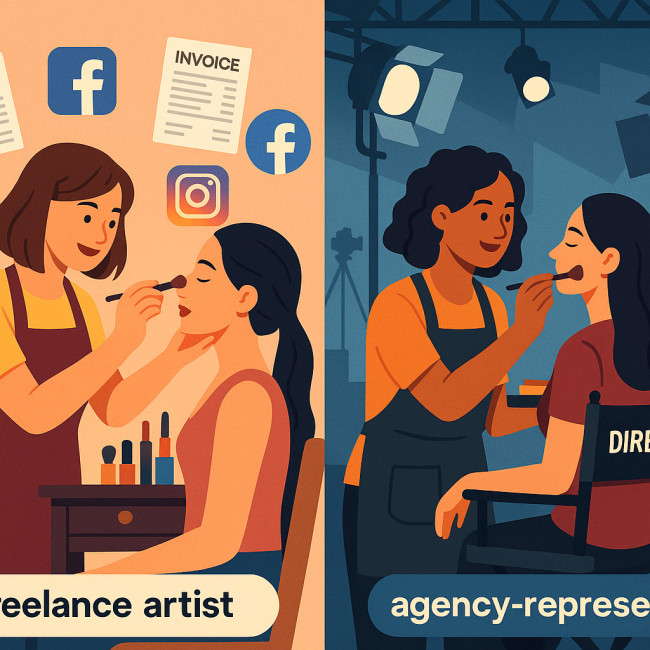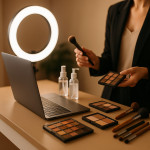Freelance or agency roster? Guiding a maquilleur toward the most profitable path
Should you stay independent or sign with an agency roster? This guide dissects earning potential, workload, and long-term brand impact for makeup artists—so you can choose (or switch) with confidence.
Why this decision shapes your entire career

Whether you call yourself a maquilleur, makeup artist or face designer, the business model you pick defines how often your phone rings, the rates you can charge and the freedom you retain. In a market where U.S. theatrical and performance makeup artists earned a median $75,730 in 2023, every percentage point of commission—or lack of it—matters.
The freelance route in detail
Pros that attract independent spirits
- Total rate control: You set day rates, rush fees and licensing clauses without third-party approval.
- Direct client bonds: Relationships are yours to nurture, upsell and re-book.
- Flexible branding: You decide if your Instagram grid carries bold SFX or bridal elegance this month.
- Portfolio freedom: Faster edits, behind-the-scenes reels and optimized online gallery layouts get published the moment you approve them.
Hidden downsides worth budgeting for
- Unpaid admin time: inquiries, contracts, invoicing and follow-ups.
- Irregular cash flow: peak wedding season vs. winter lulls.
- Marketing costs: paid ads or directory premium slots come out of pocket.
- No gatekeeper credibility: some luxury clients still equate agency stamp with quality.
The agency roster route in detail
Upsides that tempt busy artists
- Pre-qualified briefs: Producers and brands approach you already vetted and budget-approved.
- Negotiation muscle: Senior agents often secure 15–30 % higher gross fees than solo artists quote.
- Streamlined admin: Contracts, payment chasing and insurance certificates sit on the agency desk, not yours.
- Cross-sell potential: Roster mates (stylists, hair pros) create package deals that boost your billable days.
Compromises you must accept
- Commission—usually 20 % on domestic jobs and up to 30 % on overseas gigs.
- Brand dilution: your name is secondary to the agency label on call sheets.
- Portfolio restrictions: some agencies veto certain collaborations or social posts.
- Exclusivity clauses can block lucrative side projects like private masterclasses.
Profit snapshot: freelance vs. agency
| Metric (per year) | Freelance | Agency Roster |
|---|---|---|
| Average billed day rate | $550 | $700 |
| Booking days (median) | 110 | 120 |
| Gross income | $60,500 | $84,000 |
| Commission/Admin costs | $6,500 (self-marketing) | $16,800 (20 % agency fee) |
| Net take-home | $54,000 | $67,200 |
Source : U.S. Bureau of Labor Statistics
Decision matrix: which path fits your goals?
- How niche is your style? Avant-garde SFX artists with few direct competitors thrive solo. Bridal specialists in saturated markets often benefit from agency pitching power.
- Are you business-savvy? If accounting apps and invoice templates excite you, freelance admin won't feel heavy.
- Do you crave schedule stability? Rosters fill calendars months ahead, ideal for parents or artists balancing teaching commitments.
- What's your five-year vision? Building a personal e-shop, online course or product line fits better with freelance autonomy.
Boost profit whichever path you pick
Universal revenue accelerators
- Publish sincere client reviews; diverse proof points win premium briefs. See these inclusive skin tone techniques.
- List availability in real time to catch last-minute jobs via platforms like Artfolio's collaboration board.
- Negotiate clear usage rights upfront; commercials running on both TV and TikTok warrant multi-channel fees.
- Track every metric—conversion rate, repeat bookings, average basket size—then tweak offers quarterly.
Extra tips for freelancers
- Bundle services (makeup + simple hair) to raise per-day rates by 25 % without extra travel.
- Automate reminders and deposits to cut no-shows; many artists use 30 % upfront.
- Apply dynamic pricing during high-demand events such as Cannes or Fashion Week.
Extra tips for agency-signed artists
- Pitch education gigs (masterclasses) through your agent to tap corporate training budgets.
- Review contract renewal clauses annually; cap exclusivity to core markets so you can freelance abroad.
- Request cross-roster promotions—pair with photographers who need reliable makeup partners.
Mini-Quiz: Are you roster-ready?
FAQ
- Can I be freelance and on an agency roster simultaneously?
- Yes, if your contract is non-exclusive or geographically limited. Negotiate carve-outs for private clients or online courses.
- What commission rate is standard?
- Domestic jobs usually incur 15–20 % agency commission; international campaigns may reach 25–30 % because the agency handles visas, insurance and currency risk.
- How long does it take to secure an agency?
- Expect three to six months. Agencies review portfolios, request test shoots and sometimes a probation period before formal signing.
- Do agencies cover kit expenses?
- Rarely. You still supply and restock your own products. Build kit depreciation into your rate whether freelance or rostered.
Key takeaways
Going solo maximises creative control and brand equity; signing with a roster boosts volume and headline rates. Crunch your numbers, revisit goals annually and remember—you can pivot. Whichever route you choose, maintain a data-driven approach to pricing, update your portfolio quarterly and keep learning.
Ready to act? Compare today's briefs, polish your terms and start pitching. Your most profitable season begins now.











